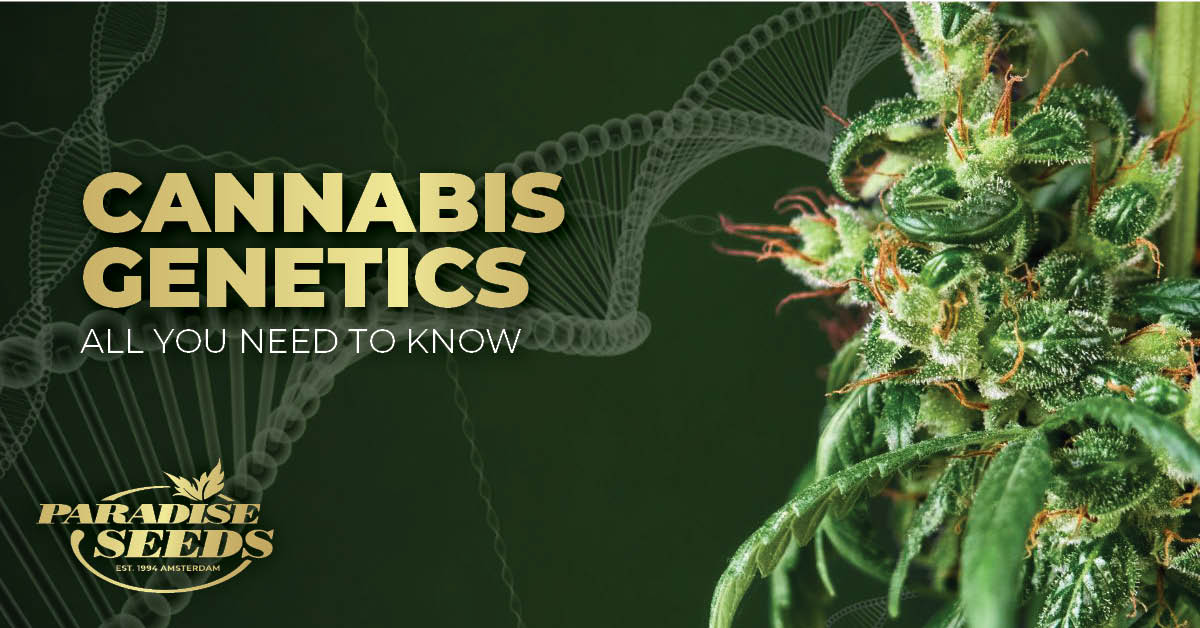If you sow a seed a plant will grow, but not all seeds are created equal! One of the first essential bits of cannabis knowledge to grasp is this fact, because quality cannabis genetics are the product of a sophisticated breeding process.
The wonderful world of cannabis genetics is a story of pioneering research, breeding experimentation and development of stable varieties which display distinctive – and often unique – attributes in respect to growth, yield, smell/flavor and strength.
This guide will take you through the various aspects of cannabis genetics and the role they play in developing different types of plants grown from cannabis seeds. It highlights the role of genetics in shaping different strains, how the breeding process works and the different types of cannabis seeds.
Contents
What does the term cannabis genetics mean?
Every living organism passes on traits in the form of inherited characteristics through reproduction. This is as true for a person whose height, body shape and eye color comes from the DNA of their parents as it is for a cannabis plant bred from two parent plants.
The blueprint of a person, or a plant is made up of the genes of their parents. This is the simple explanation for understanding the process of cannabis genetics. Let’s take a cannabis strain such as Paradise Seeds’ Caramba as an example.
The parents of Caramba are Wappa and Gelato 33. The genes of each parent plant combine to provide the genetic code for Caramba, creating its distinctive growth pattern, combination of cannabinoids, and the way the plant smells and tastes.
These are the obvious characteristics resulting from a plant’s cannabis genetics, but the genetic code contains numerous less obvious attributes – for example factors such as how high it will grow, how quick it will flower and how resistant it is to hostile elements like disease and mold.
Sativa, Indica, and Hybrids: The Genetic Spectrum
Although humans have been cultivating cannabis genetics for an estimated 12,000 years the cannabis plant has been growing on the planet for millions of years according to scientific research.
Just over a million years ago, in the Pleistocene Epoch (to put it into context, this was when early humans were hunting on the plains of Africa), the cannabis plant is believed to have diverged into two species, showing different characteristics – sativa and indica.
The differences between sativa and indica plants include growth pattern, leaf shape, flowering time and, for the cannabis consumer, difference in effect.
Sativa cannabis seeds produce plants which are tall and more spindly, have narrower leaves, a longer flowering time and give a more energetic, uplifting effect. In contrast, indica cannabis seeds grow short, bushy plants with a shorter flower time and a heavier relaxation effect.
These traditional species grow naturally around the world and are often referred to as land races. Indica land races tend to grow in the Indian subcontinent (such as the Hindu Kush region), while sativas are found close to the equator across South America, Africa and Southeast Asia.
At the beginning of the Twenty First century, pioneering cannabis breeders experimenting with cannabis genetics in Europe and the USA developed hybrid cannabis seeds. These plants merged the best characteristics of sativas and indicas to create a new generation of cannabis plants.
Hybrid weed plants have changed the cannabis cultivation landscape, allowing growers to pick and choose plant qualities – for example a sativa effect combined with a more indica growth pattern and bigger yield.
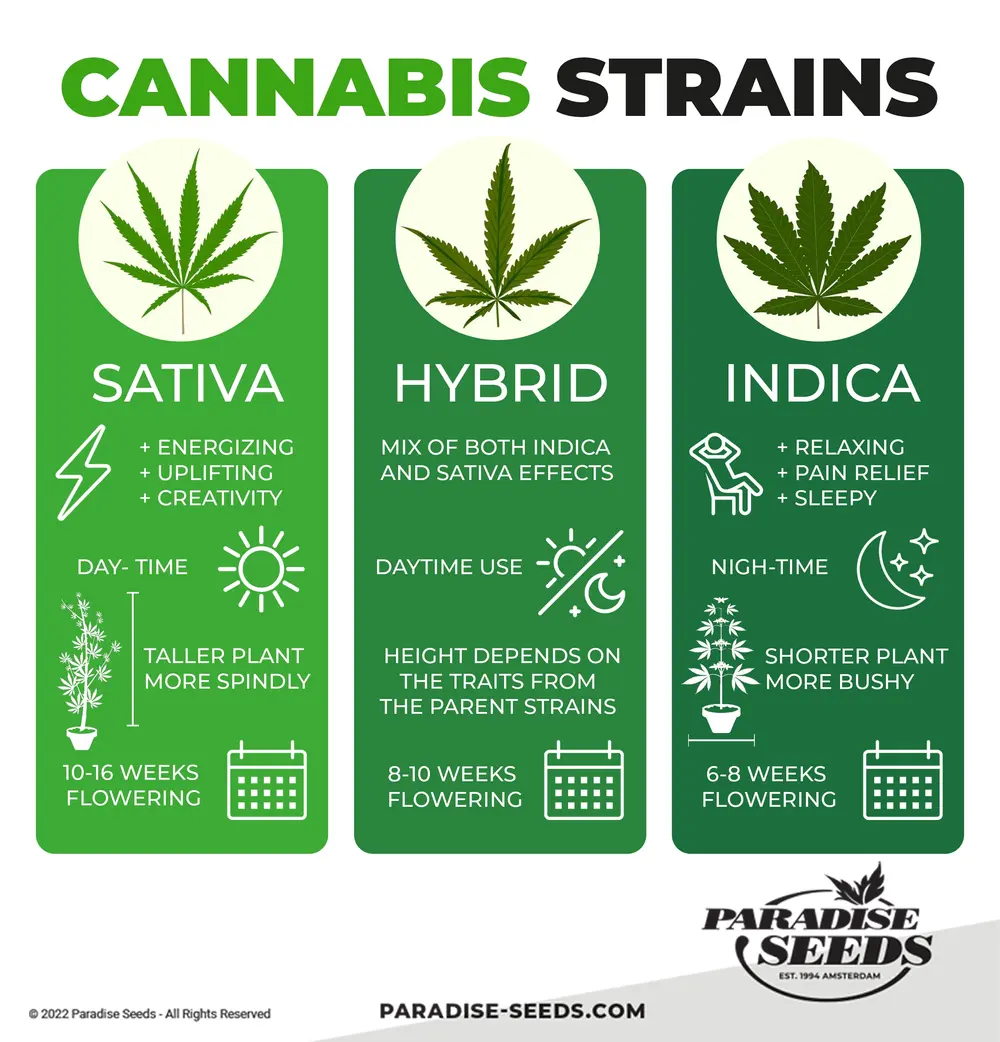
The role of breeding in cannabis genetics
Genetics – what’s in the heritage of a plant – play a crucial role in pinpointing the exact qualities a grower is after. This is why cannabis breeding is the key to developing strains which provide cultivators with desirable traits.
As cannabis breeding has evolved over the past 30 years, classic cannabis strains such as White Widow, Dutch Dragon and Sensi Star have been ‘stabilized’. This means that over generations of breeding, plants grown from these cannabis seeds display uniform and consistent growth i.e. you plant 5 seeds of Sensi Star and the 5 plants grow the same way, look the same and produce with the same consistency.
But as the cannabis industry has developed, so has the appetite amongst growers for new strains which provide something different. Therefore cannabis breeders will experiment by taking two parent plants with particular characteristics with the intention of creating offspring which carry aspects of each plant.
An example of this is the combination of a particular growth pattern with a particular effect, or the accentuation of one of the parent plant’s existing characteristics, such as boosting a terpene profile.
Developing great cannabis genetics is not something that happens overnight. A reputable seed bank can spend anything up to two years evolving a new strain, making sure that it is stable and uniform and delivers consistent performance. For this reason, cheap bulk seeds will often bring disappointment as they really are a mixed bag.
Famous cannabis genetics
The explosion of new varieties in recent years is the result of the revolution in breeding cannabis genetics. While the world seems to be running out of names for new weed strains, there are some which have become notorious.
These distinguished genetics may be popular because of their all round qualities and reliable performance, their unique taste, or the strength of their effect. A sample of household name strains includes:
- White Widow, the legendary Dutch strain renowned for its potency and reliable performance, which makes it a breeding block for many new strains.

- Original Haze cannabis genetics have produced many Haze variations over the years, with a distinctive taste and an energetic effect which set the bar high for sativa strains.
- Cookies is a plant which typifies the rise of the Californian hybrid strain in the past decade, with pronounced flavor and potency.

- Gelato is another Californian variety which has established itself as a distinctive strain with its mix of Sunset Sherbert and Thin Mint Cookies genetics.
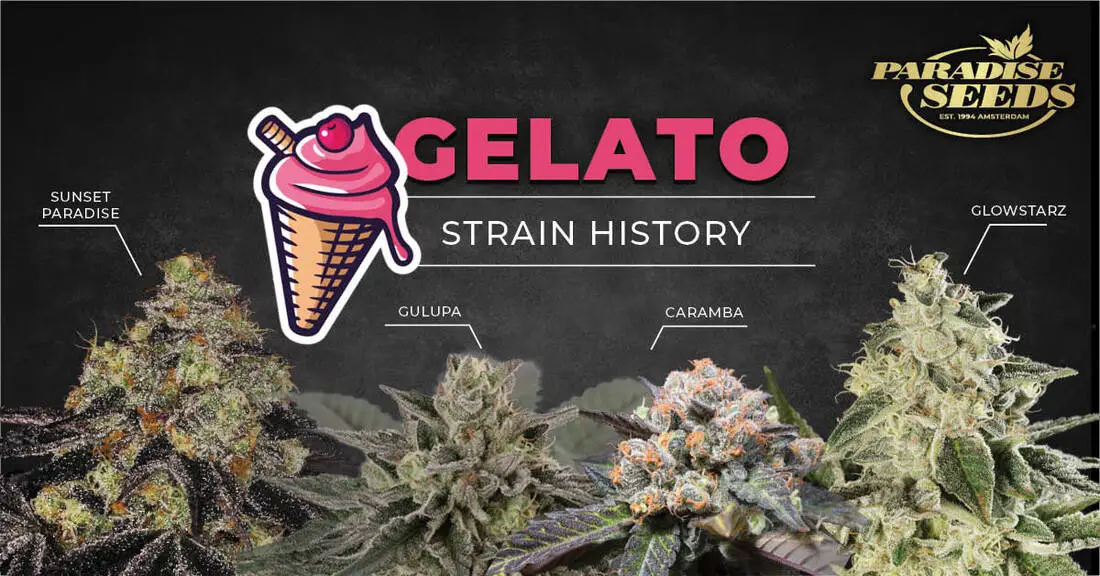
The cannabis breeding process
Professional cannabis breeders are able to conduct breeding on a large scale using breeding chambers. Male plants are installed with female plants to carry out pollination naturally, or breeders will use artificial pollination techniques.
Selected parent plants will often be prized specimens which are many years old and maintained in a state of vegetation in other chambers so that they never flower.
However, cannabis genetics breeding is not just for the professionals! It can also be carried out by the home growers.
Cannabis breeding genotypes and phenotypes
The cannabis genetics breeding process develops from genotypes and phenotypes.
What is a genotype?
This is the makeup of a cannabis plant’s genetic code (i.e. DNA). The genotype encompasses all the genetic information passed down from the parent plants. It holds the potential for all the characteristics of the parent plants, both dominant and recessive.
What is a phenotype?
This is the sum of a plant’s observable characteristics. It’s influenced by the genotype but also by other factors like the environment.
Just as two parents produce children which look different (although sharing similar features), a cross between two cannabis genotypes will produce different phenotypes through the first generations of the breeding process.
While the phenotypes will display common traits such as height, leaf and bud structure and a similar cannabinoid and terpene composition, certain plants will stand out as different, exhibiting desirable characteristics. Maybe they are stronger than the others, exhibit differences in growth structure, be more aromatic or display a distinctive flavor.
Cannabis phenotype hunting
Phenotype (or ‘pheno’) hunting is a common practice in cannabis breeding. Finding those plants which stand out from a room of similar plants is used for:
- New strain development: Desirable characteristics can be identified in a phenotype, which is then used as the basis for further breeding.
- Trait selection: Perhaps the breeder is looking to reinforce the stability and performance of an existing strain, such as improving resistance qualities.
Consistency: Commercial growers, such as Licensed Producers (LPs) will use phenotype hunting as a way of ensuring uniformity of crop when growing on a large scale.
Common cannabis breeding terms
F1 Hybrids
This term stands for ‘first filial generation’ and it refers to the first generation of offspring from two purebred parent plants. They display heterozygosity (having different alleles for a particular trait), heterosis (showing improved growth/health to their parent plants)
and uniformity.
Backcrossing
In this process, the original parent line is crossed with the first-generation offspring. By going through this procedure, plants achieve a higher stability rate and breeders can be more certain of desired parental line characteristics.
Selfing
This process is also referred to as self-pollination (or self-fertilization). It involves pollinating a female cannabis plant with its own pollen to produce plants that are genetically very similar to the parent plant. The offspring inherit a set of genes from both the mother and father (which, in this case, are the same plant). Selfing is a form of inbreeding (see IBL description below).
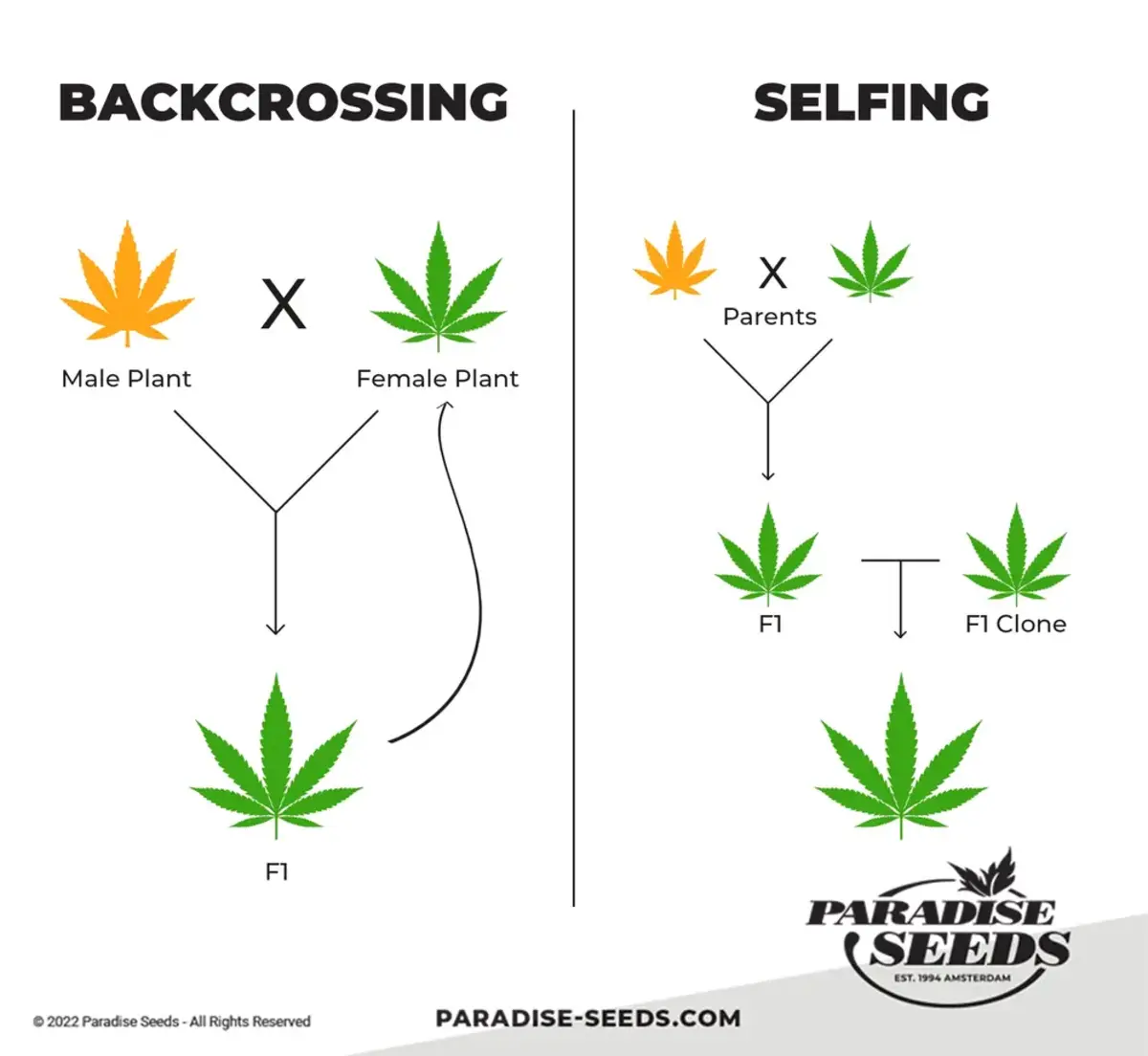
IBL (In Bred Line)
Inbred lines have been selectively bred for many generations to stabilize specific traits and characteristics, resulting in a genetically uniform line of plants. IBL plants provide consistent characteristics such as appearance, aroma, flavor and cannabinoid content.
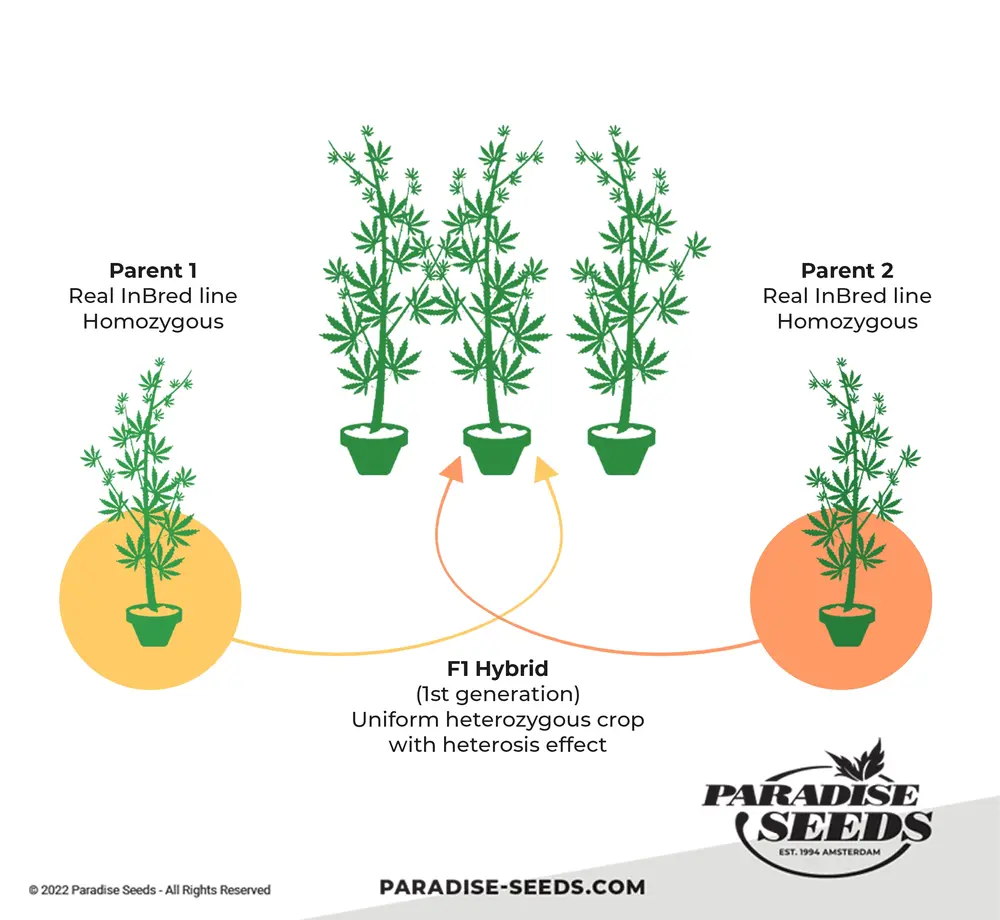
Different types of cannabis seeds
A natural occurrence of pollination is the production of cannabis seeds. Originally, cannabis breeders worked with selected landrace seeds. In the late Twentieth century, hotspots of seed collection and breeding could be found in Amsterdam and California.
Travelers coming from known landrace destinations such as India, Thailand, parts of South America and Africa exchanged seeds. Breeders took these and experimented to develop plants which were adapted and naturalized for growing in areas away from their native habitats (such as northern Europe), and indoors under lights.
This period of experimentation has brought different types of cannabis seeds to the market over the years:
As we learn more about the cannabis plant, it is inevitable that more advances in the area of cannabis genetics will be made in the future which will provide increased options in the recreational and medical cannabis sectors.
Photoperiod cannabis seeds
Photoperiod refers to plants which flower based on the amount of light/dark hours they receive. Changing the light schedule to 12/12 will induce the flowering stage.
Regular photoperiod cannabis seeds: This was the first generation of popular cannabis seeds. ‘Regular’ refers to seeds which are not sexed, so a batch may have included male and female plants. Growers would only find out when the plants were old enough to determine their sex. the uncertainty was often frustrating for growing plans.
Feminized photoperiod cannabis seeds: This development was a game changer in the cannabis industry. In the early 2000s, companies such as Paradise Seeds in Amsterdam released feminized versions of their popular strains. Feminized photoperiod cannabis seeds
contain no males. This provided certainty for cultivators that the seeds they planted would all be female.
Autoflower cannabis seeds
This was another innovation in the early 2000s. By crossing photoperiod cannabis genetics with a species of cannabis found in the Arctic circle, cannabis ruderalis, breeders developed a quick flower plant. Smaller in size, flowering regardless of light hours, autoflowers offer the grower a guaranteed finish within 60 – 70 days.
Indoor cannabis seeds
While there is no such thing as a specific ‘indoor cannabis seed’, some photoperiod strains are better suited for the indoor grow space. This can be because they are good for using with different cannabis grow techniques or can deliver optimized performance with good management and a controlled environment
Outdoor cannabis seeds
Likewise, there is no specific ‘outdoor cannabis seed’, but there are good outdoor growing performance strains, as a result of their cannabis genetics. Outdoor autoflowers are popular with those growing in nature in northern latitudes, allowing cannabis cultivators to take advantage of the strength of the midsummer sun.
Conclusion
Cannabis genetics is a fascinating topic and one which captivates the attention (and imaginations!) of cannabis growers around the world. Nature provided the building blocks in the form of land races, but breeders have pushed the boundaries to make cannabis strains truly accessible and adaptable to most growing environments.
The choice of effects and flavors, combined with factors such as yields and growth patterns and different THC/CBD levels , means that cultivators really can tailor the growing experience to their preferences.
As well as recreational enjoyment, the evolution of cannabis genetics has also seen the rise of the medical cannabis sector, with some strains recognized as having benefits for particular medical conditions. This area will only be explored now that cannabis has been assessed as having medical research value.


